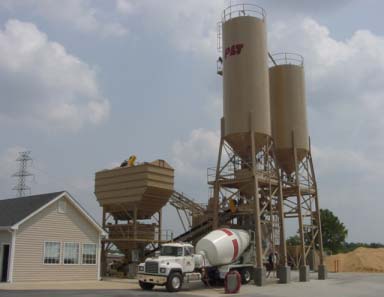From the Portland Cement Association.
In its simplest form, concrete is a mixture of paste and aggregates, or rocks. The paste, composed of portland cement and water, coats the surface of the fine (small) and coarse (larger) aggregates. Through a chemical reaction called hydration, the paste hardens and gains strength to form the rock-like mass known as concrete.
Within this process lies the key to a remarkable trait of concrete: it’s plastic and malleable when newly mixed, strong and durable when hardened. These qualities explain why one material, concrete, can build skyscrapers, bridges, sidewalks and superhighways, houses and dams.
Proportioning
The key to achieving a strong, durable concrete rests in the careful proportioning and mixing of the ingredients. A mixture that does not have enough paste to fill all the voids between the aggregates will be difficult to place and will produce rough surfaces and porous concrete. A mixture with an excess of cement paste will be easy to place and will produce a smooth surface; however, the resulting concrete is not cost-effective and can more easily crack.
Portland cement’s chemistry comes to life in the presence of water. Cement and water form a paste that coats each particle of stone and sand—the aggregates. Through a chemical reaction called hydration, the cement paste hardens and gains strength.
The quality of the paste determines the character of the concrete. The strength of the paste, in turn, depends on the ratio of water to cement. The water-cement ratio is the weight of the mixing water divided by the weight of the cement. High-quality concrete is produced by lowering the water-cement ratio as much as possible without sacrificing the workability of fresh concrete, allowing it to be properly placed, consolidated, and cured.
A properly designed mixture possesses the desired workability for the fresh concrete and the required durability and strength for the hardened concrete. Typically, a mix is about 10 to 15 percent cement, 60 to 75 percent aggregate and 15 to 20 percent water. Entrained air in many concrete mixes may also take up another 5 to 8 percent.
Other Ingredients
Almost any natural water that is drinkable and has no pronounced taste or odor may be used as mixing water for concrete. Excessive impurities in mixing water not only may affect setting time and concrete strength, but can also cause efflorescence, staining, corrosion of reinforcement, volume instability, and reduced durability. Concrete mixture specifications usually set limits on chlorides, sulfates, alkalis, and solids in mixing water unless tests can be performed to determine the effect the impurity has on the final concrete.
Although most drinking water is suitable for mixing concrete, aggregates are chosen carefully. Aggregates comprise 60 to 75 percent of the total volume of concrete. The type and size of aggregate used depends on the thickness and purpose of the final concrete product
Relatively thin building sections call for small coarse aggregate, though aggregates up to six inches in diameter have been used in large dams. A continuous gradation of particle sizes is desirable for efficient use of the paste. In addition, aggregates should be clean and free from any matter that might affect the quality of the concrete.
Hydration Begins
Soon after the aggregates, water, and the cement are combined, the mixture starts to harden. All portland cements are hydraulic cements that set and harden through a chemical reaction with water call hydration. During this reaction, a node forms on the surface of each cement particle. The node grows and expands until it links up with nodes from other cement particles or adheres to adjacent aggregates.
Once the concrete is thoroughly mixed and workable it should be placed in forms before the mixture becomes too stiff.
During placement, the concrete is consolidated to compact it within the forms and to eliminate potential flaws, such as honeycombs and air pockets.
For slabs, concrete is left to stand until the surface moisture film disappears, then a wood or metal handfloat is used to smooth off the concrete. Floating produces a relatively even, but slightly rough, texture that has good slip resistance and is frequently used as a final finish for exterior slabs. If a smooth, hard, dense surface is required, floating is followed by steel troweling.
Curing begins after the exposed surfaces of the concrete have hardened sufficiently to resist marring. Curing ensures the continued hydration of the cement so that the concrete continues to gain strength. Concrete surfaces are cured by sprinkling with water fog, or by using moisture-retaining fabrics such as burlap or cotton mats. Other curing methods prevent evaporation of the water by sealing the surface with plastic or special sprays called curing compounds.
Special techniques are used for curing concrete during extremely cold or hot weather to protect the concrete. The longer the concrete is kept moist, the stronger and more durable it will become. The rate of hardening depends upon the composition and fineness of the cement, the mix proportions, and the moisture and temperature conditions. Concrete continues to get stronger as it gets older. Most of the hydration and strength gain take place within the first month of concrete’s life cycle, but hydration continues at a slower rate for many years.
Read the article on Cement.org

